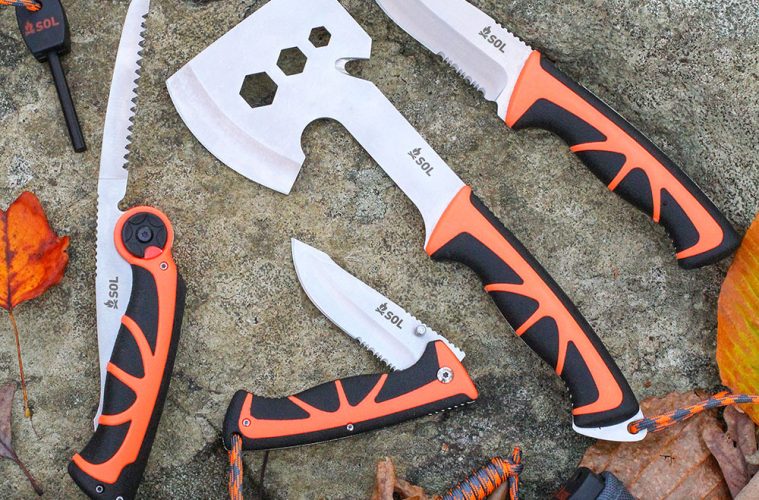SURVIVE OUTDOORS LONGER WITH THESE FOUR ADVENTURE-READY TOOLS
The weather was getting cooler by the day. The leaves were changing as if I were walking into an autumn painting. Because the temperatures weren’t too low, I opted for a small campfire, but first had to hang my tarp before starting the much-needed work that lay ahead—with a bit of help, of course.
SOL
The acronym SOL stands for Survive Outdoors Longer. When it comes to purpose-driven equipment for adventures and survival, SOL gear is the first company that comes to mind. Known for its innovative survival kits, emergency shelters, fire kits, and signaling devices, the SOL brand is synonymous with pure adventure.
Adventure Ready Brands owns and operates about 10 popular brands besides Survive Outdoors Longer, including Ben’s, Natrapel, and Adventure Medical Kits. Adaptability and change are two concepts that Adventure Ready Brands strongly embraces.
SOL STOKE CAMP HATCHET
The Stoke Camp Hatchet is designed to be an all-in-one fire-starting tool. The integrated rope cutter is meant to cut a piece of the included tinder cord lanyard and ignite it by striking the ferrocerium rod with the blade. The bite-sized hatchet is made from 420 stainless steel, with sure-grip polypropylene/TPR (thermoplastic rubber) handle construction like all the Stoke cutting tools.
“The bite-sized hatchet is made from 420 stainless steel, with sure-grip polypropylene/TPR…handle construction like all the Stoke cutting tools.”
And hey, if you need a wrench in the woods, use one of the three included hex wrenches. A riveted belt sheath completes the package, protecting the blade and other gear if you stow it in your pack. The nylon sheath also provides storage for the included ferrocerium rod. As an added benefit, the integrated rope cutter doubles as a bottle opener, so you can sit back and enjoy your heroic camp victories next to the fire.
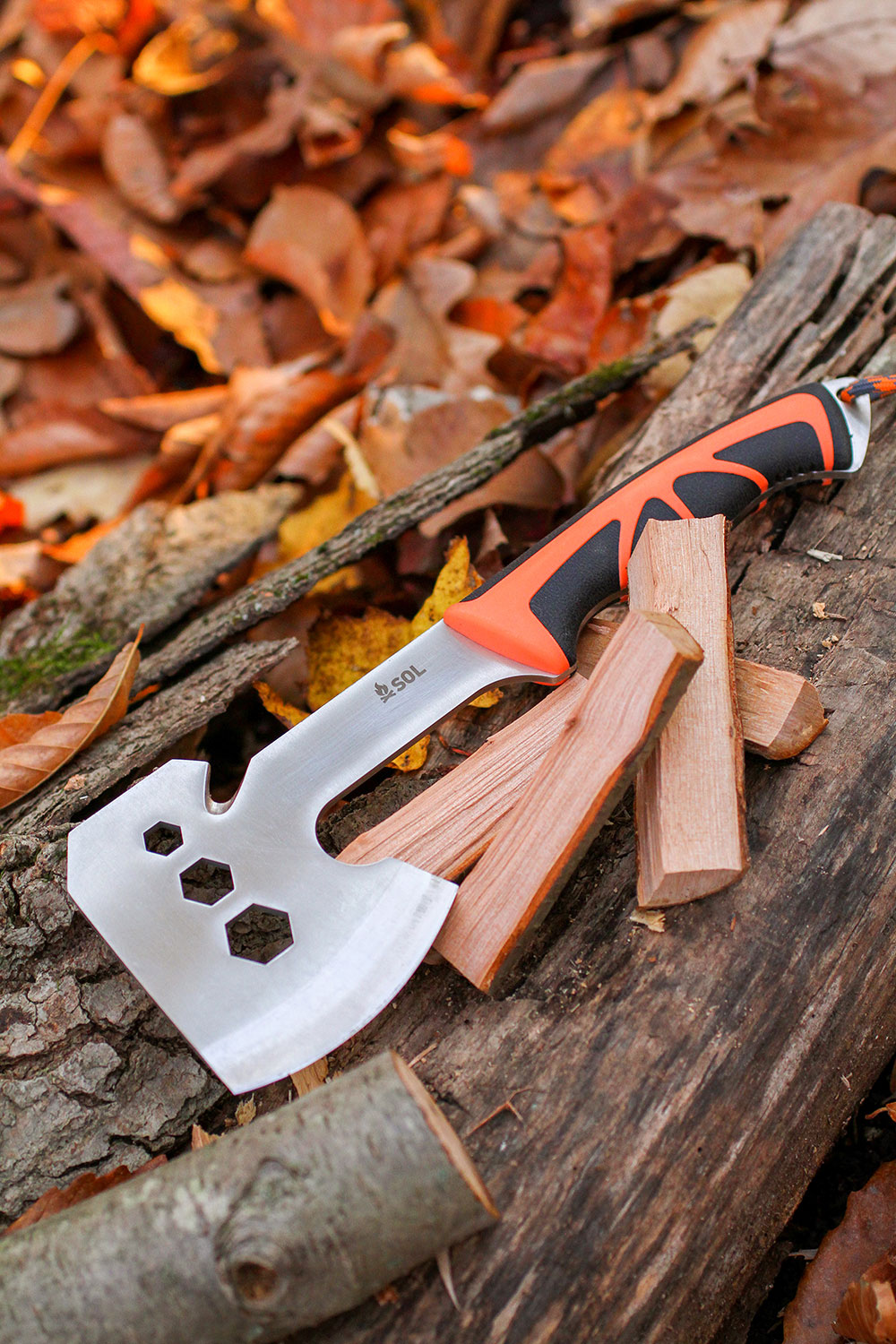
The hatchet was used to split dried beech rounds slightly larger in diameter than a broomstick with no issues. The wood was split with and without the aid of a stout maul as a baton.
Although SOL calls this a hatchet, it does not have the weight of a standardized hatchet most people are accustomed to using. The hatchet, by itself, weighs 10 ounces, just a little bit more than a medium-sized fixed-blade knife, which made me think of it as a crafting hatchet.
Back to the start of this story, autumn camping was here, and before hanging my tarp over the hammock correctly, I needed to craft some stakes from green witchhazel. I procured some semi-green wood from a recently blown-down tree and salvaged some straight branches for crafting.
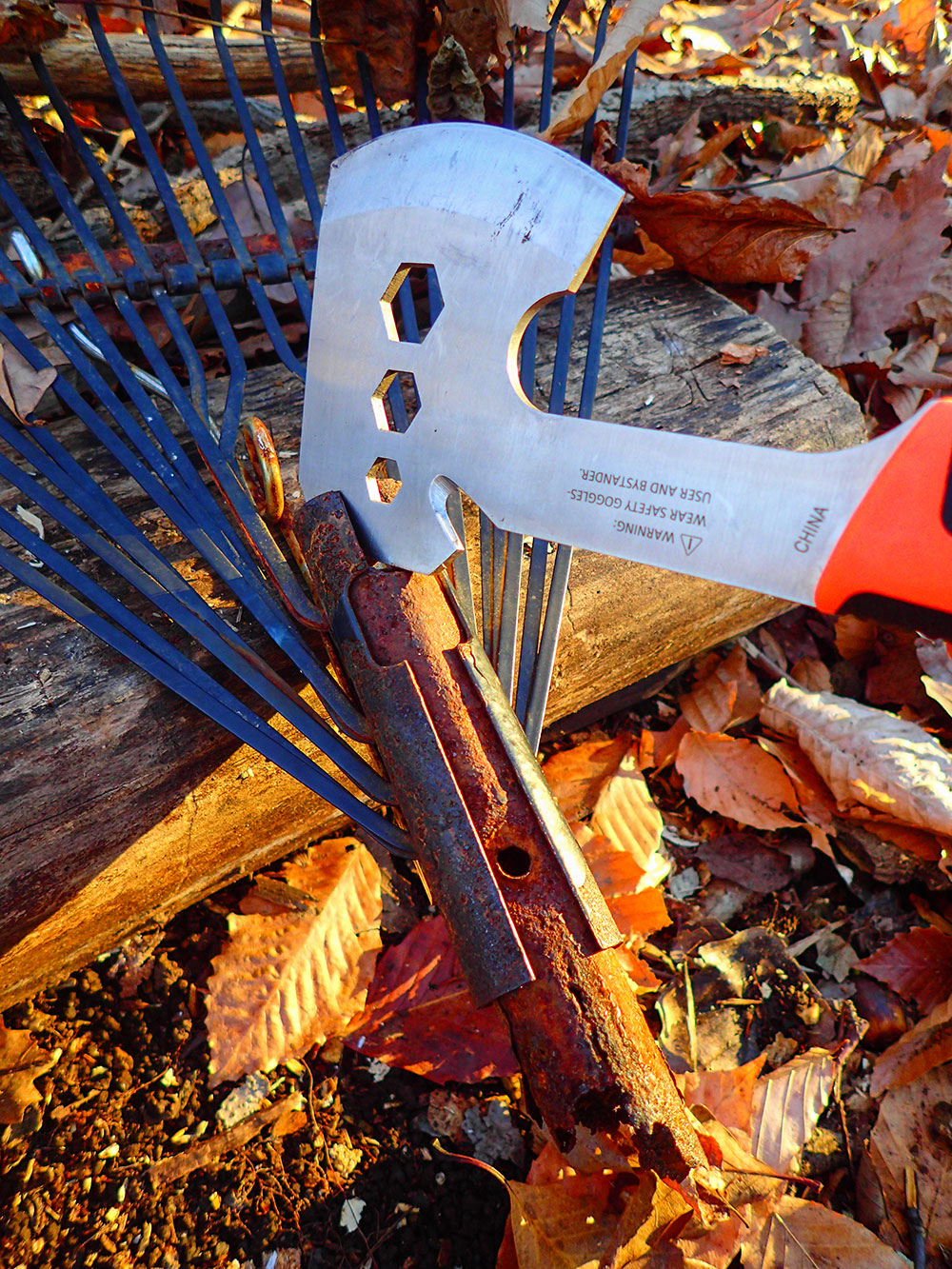
An old rake was found in the woods and needed to be refurbished. The hammer portion of the hatchet knocked out the old, rusted handle easily.
I cut a few long branches about thumb- to broomstick-thickness for my stakes. I used the hatchet to chop a 90-degree flat as the top of a stake, then about a forearm’s length down chopped a 45-degree angle as my end piece that would be stuck in the ground. I used the remainder of the stick following the same method, which gave me about four stakes, with one having a natural forked end—automatic notch.
“The Stoke Pivot Knife & Saw goes from knife to saw mode with the press of a button.”
To attach cordage for my tarp, I carved simple seven-notches in three of the stakes close to the flat 90-degree cut (top). I used two different methods of making this notch. First, I gave a light, controlled 90-degree chop as my stop-cut, making sure not to go in any deeper than one-third of the way into the stick.
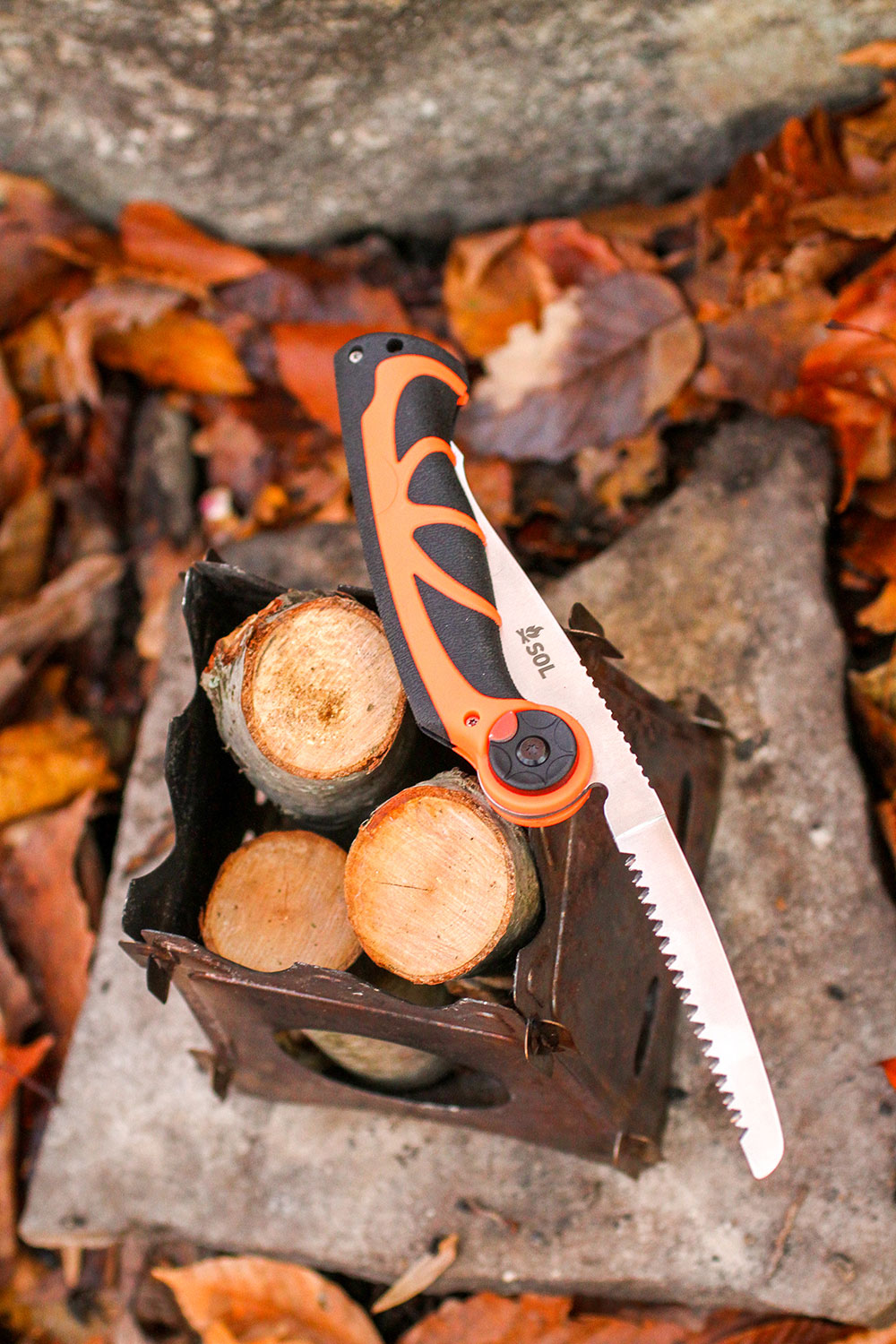
The SOL Pivoting Knife & Saw shines in saw mode. It quickly dispatched broomstick-thick pieces of deadwood for a fire.
To complete the notch, I treated the hatchet like a knife and carved it up to the stop-cut using a thumb-assisted push on the spine of the little hatchet. The little tool had a sharp blade and carved well. The second method of making the seven-notch was to use a baton in a more controlled, precise way to make my 90-degree stop-cut by hammering the blade in about one-third of the way. It only took a few whacks to the back of the Stoke to penetrate neatly. I carved the notch out with a few slices and called the stakes done—shelter up.
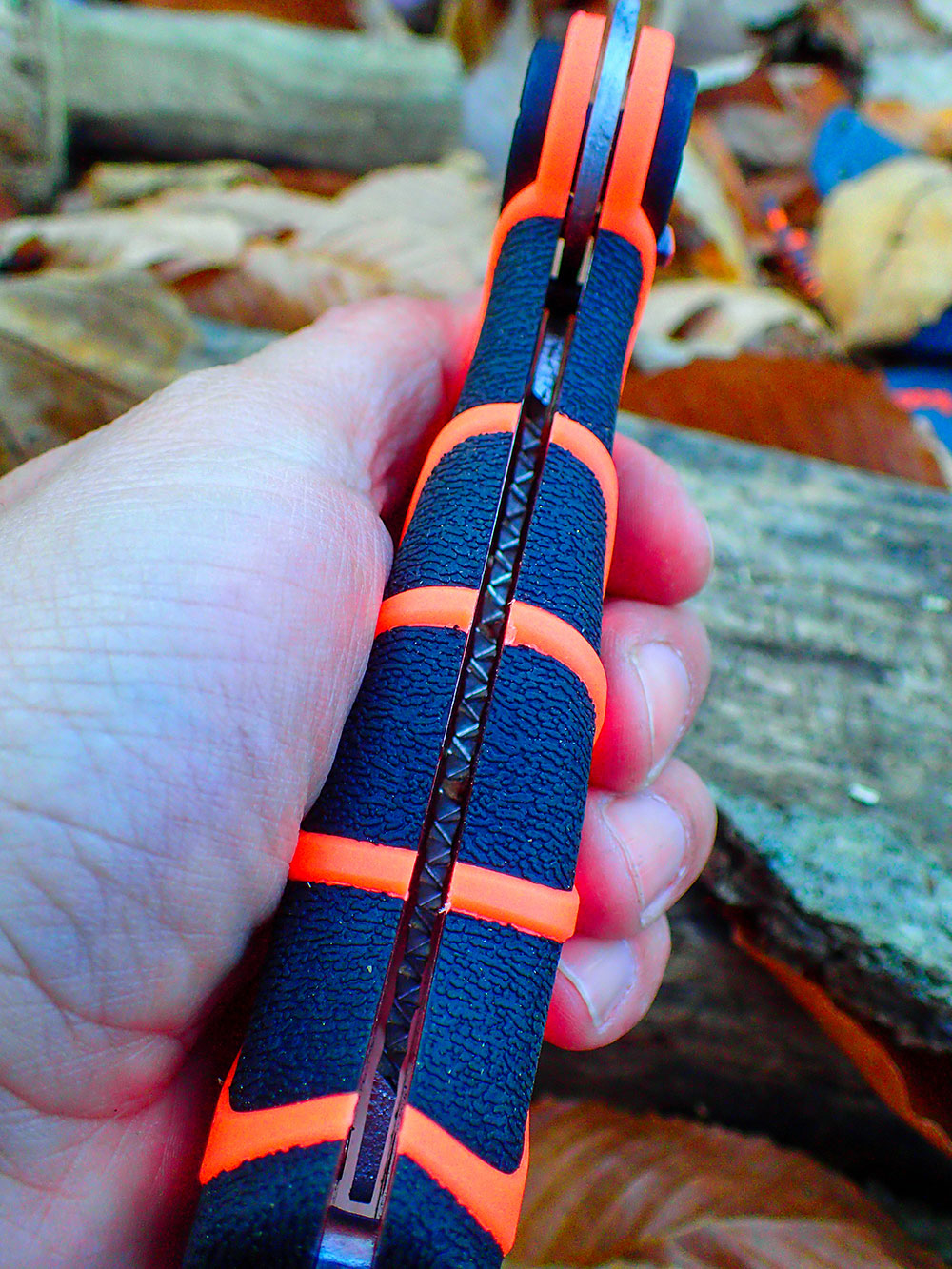
The handle of the SOL Pivoting Knife & Saw shows the saw nestled in the handle while the blade is deployed.
I used my small Uberleben twig stove for controlled cooking, meaning I didn’t need to chop wood, and splitting was kept very minimal. Wrist-thickness was the maximum width I needed to split with the help of a stout beech maul to drive the small hatchet through the wood. I also teamed the hatchet with the Stoke Pivot Knife & Saw.
2 TOOLS IN 1
The Stoke Pivot Knife & Saw goes from knife to saw mode with the press of a button. It shares the same materials and color scheme as the hatchet and offers a 3.9-inch blade or 4.25-inch saw. I found I would keep the saw deployed and use one of the other Stoke tools for my cutting needs. However, for a person wanting to take less, this two-in-one can get it done.
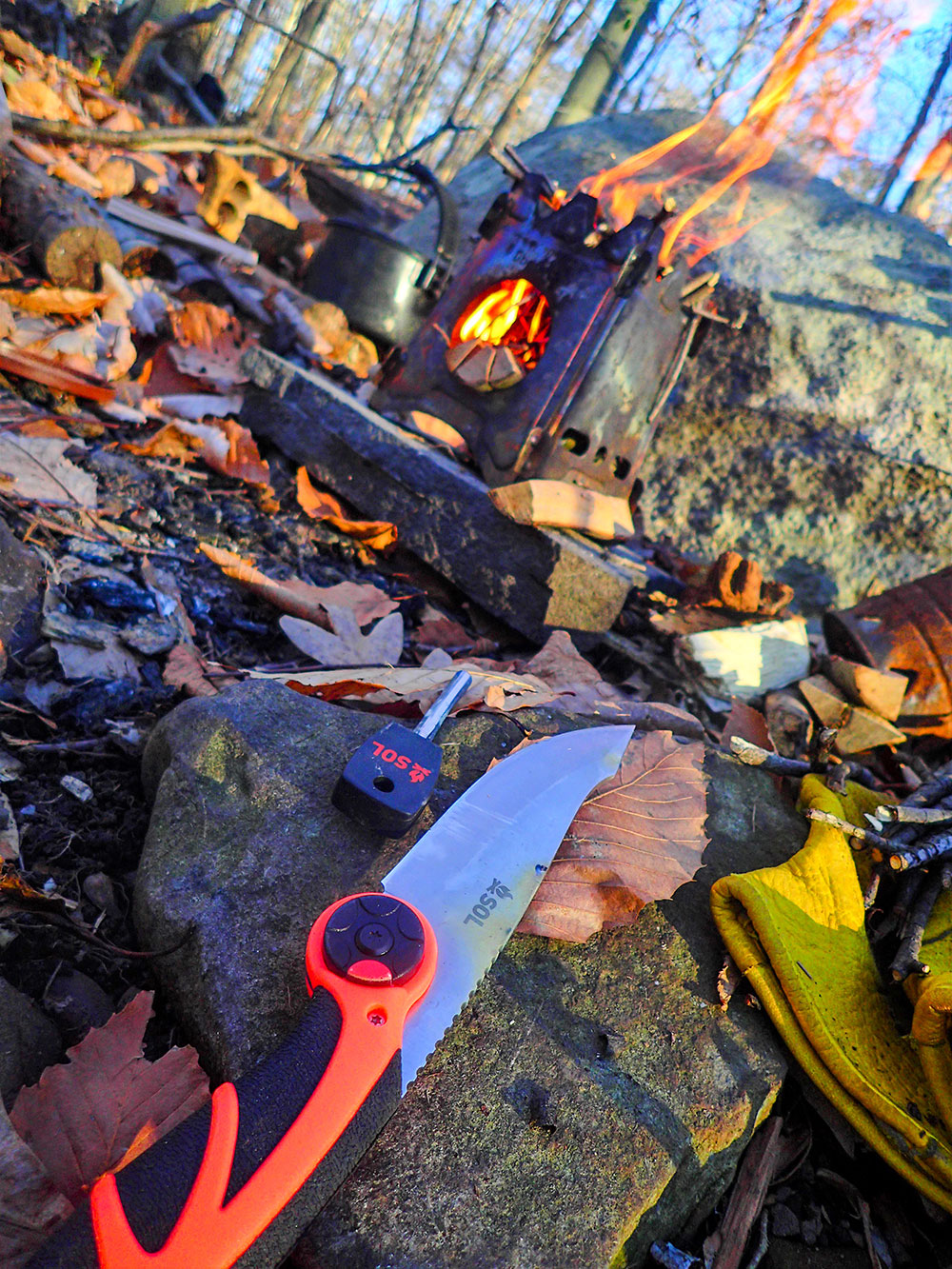
The supplied SOL ferro rod and Pivoting Knife & Saw blade spine were meant for fire starting. The 90-degree spine featured on all of the SOL cutting tools was the hidden gem of the tools.
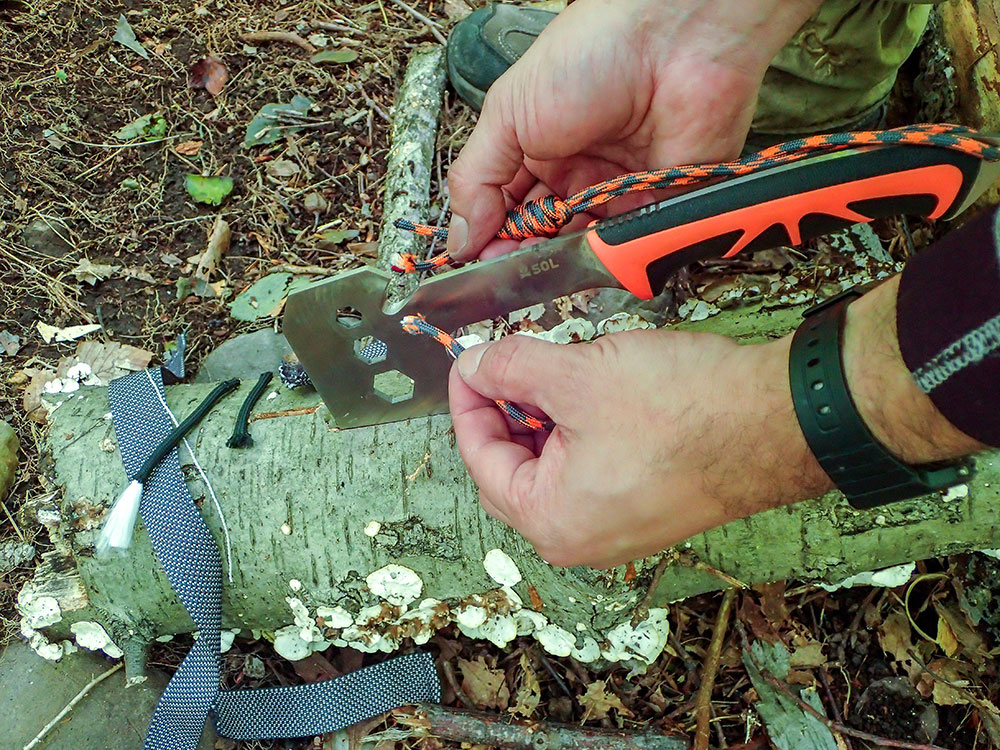
The author used the integrated rope cutter on the Stoke hatchet, which gave mixed results. Bank line and inner paracord strands were cut quickly, while nylon webbing, paracord, and the SOL tinder cord took some working back and forth to get the job done.
The handle is comfortable and more natural in knife mode than when the saw is deployed. That being said, when choking up closer to the blade, the aggressive jimping can get a little annoying on the inside of the palm. Gloves quickly eliminate that, but I wasn’t always gloved. In either position, the handle remained non-slip.
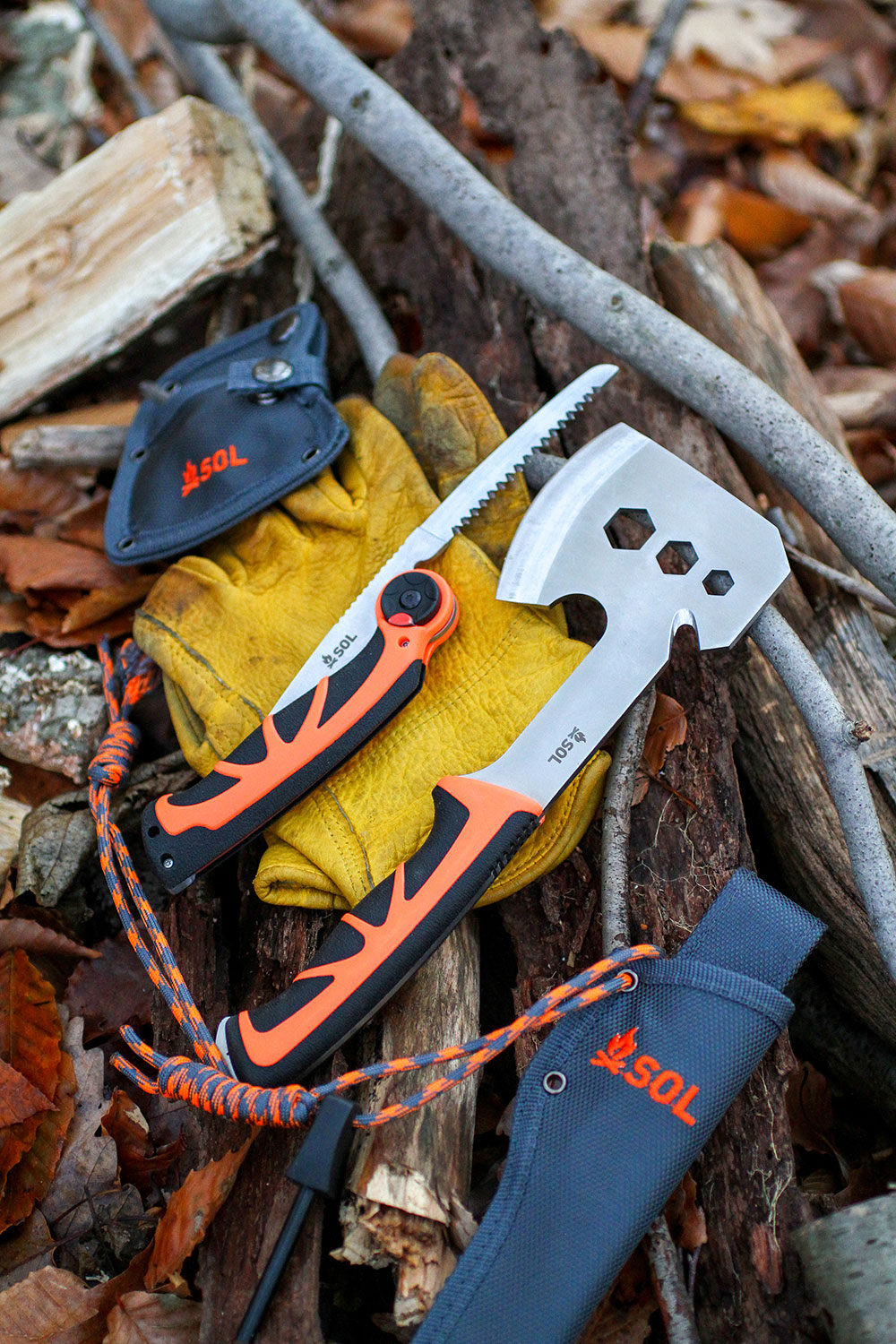
Two Stoke tools that worked in tandem for the author. A hatchet and saw can do a lot in a camp, not to mention the knife that is easily deployed with the press of a button.
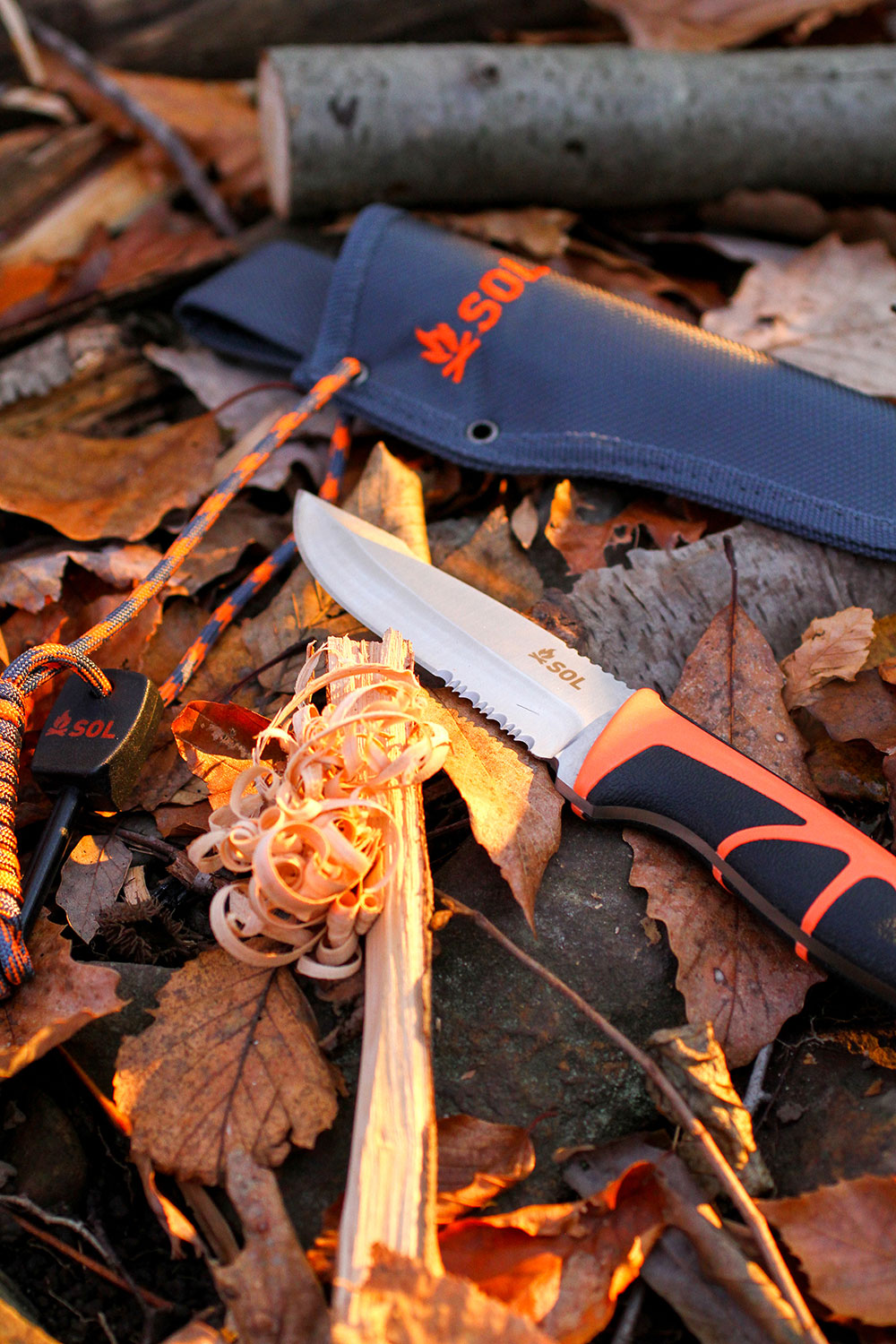
Part of the duties of a field-worthy fixed blade is to thinly shave wood for making tinder. The solid feel and sharp edge of the Stoke Field Knife handled this task firmly.
The edge was scary sharp out of the gate, as with all the Stoke tools. It was sharp and slicy, especially when making tinder from wood to ignite via the SOL ferro rod, included with every Stoke tool. I just happened to have the Pivot Knife in knife mode when it was time to shower sparks onto the tinder. I can honestly say the combination of the SOL ferro rod and their 90-degree spine was outstanding—and Fourth of July worthy.
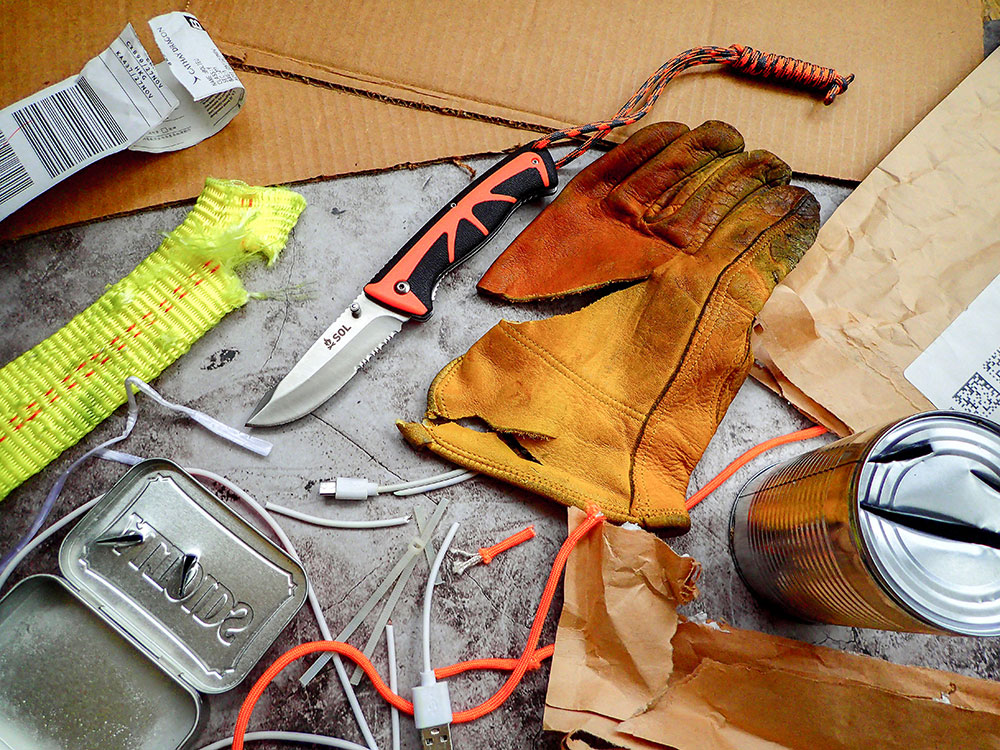
The SOL Stoke Folder was spared no quarter in the author’s gauntlet of cutting tasks.
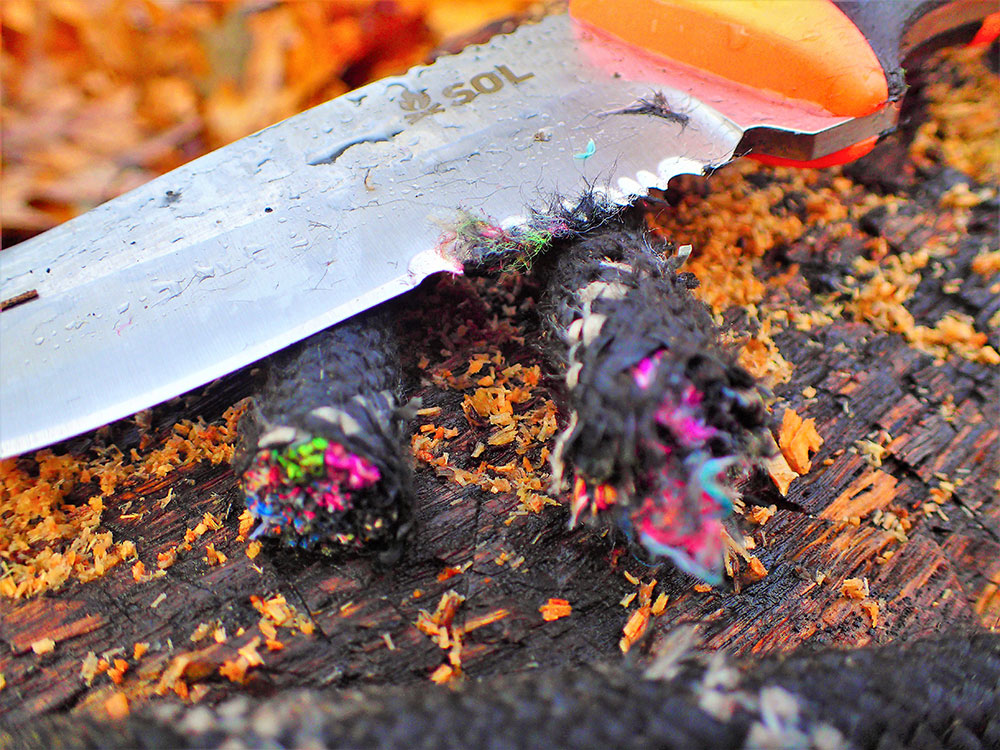
The Field Knife has serrations meant for rope and fibrous materials. Here, the plain edge was used (left) and the serrated portion (right).
I used the saw more than the knife, and it works well, especially when kept realistic and not tackling anything more than wrist thick. A good technique for sawing larger pieces is to saw about two-thirds of the way through, and baseball bat swing them onto a rock to split them off. This trick often gives an excellent exposure inside the dry wood, if you get lucky.
FULL TANG STOKE KNIFE
The Stoke Field Knife is a full-tang, 3.9-inch blade with partial serration for quick rope-cutting. It shares the same sheath style as the Pivot Knife & Saw and includes the ferro rod. It’s way more comfortable and solid than the Pivot Knife—no moving parts. It can do some light baton work for kindling, but the hatchet has that covered.
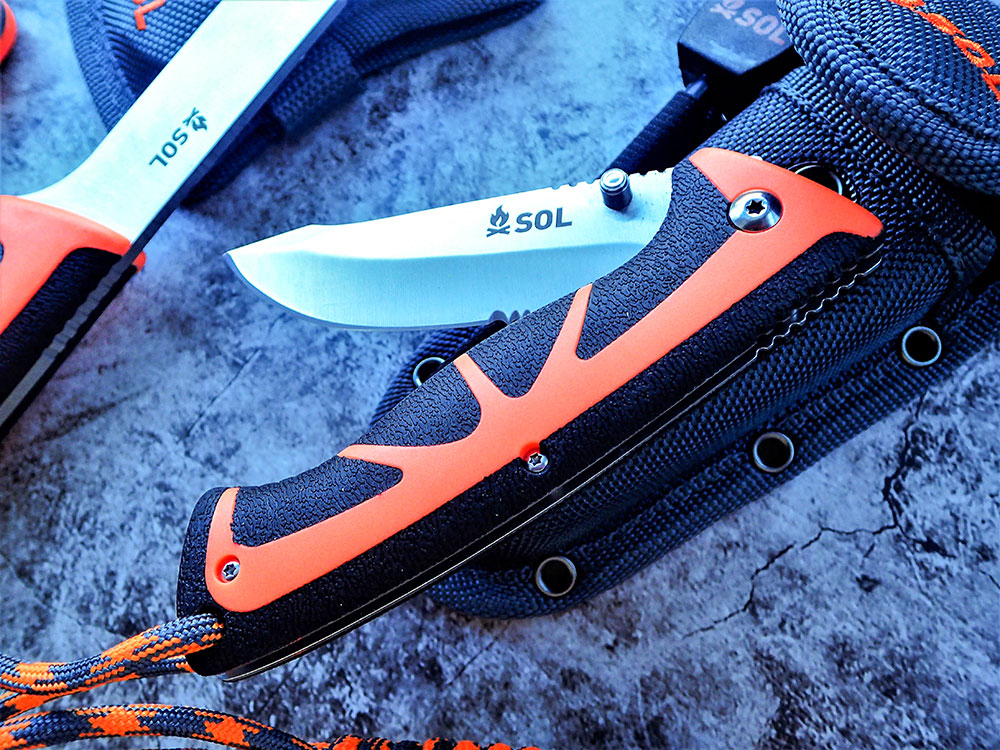
The SOL Stoke Folding Knife has a satin-finished 420 stainless steel 3.25-inch blade, serrated at the base. The PP/TPR handle construction provides a non-slip, ergonomic grip that is comfortable to use.
I used the Stoke Field Knife on some rope in camp improvised from a leash I found on the trail. I know serrations are meant for fibrous materials, however I did two tests. The serrations messily shredded the rope while the plain edge sliced through cleanly. I know that after some use, the straight edge will lose its inherent keenness, and that is when the serrations will shine on the rope.
Naturally, the full-tang was the better knife choice to baton thin sticks for fire prep when the Stoke Hatchet wasn’t around. It accomplished this task as expected, and from those thinner splits I shaved wood for the fire in the form of feather sticks. Not everyone understands how well serrations shave wood for this task, but they do—curly and fine.
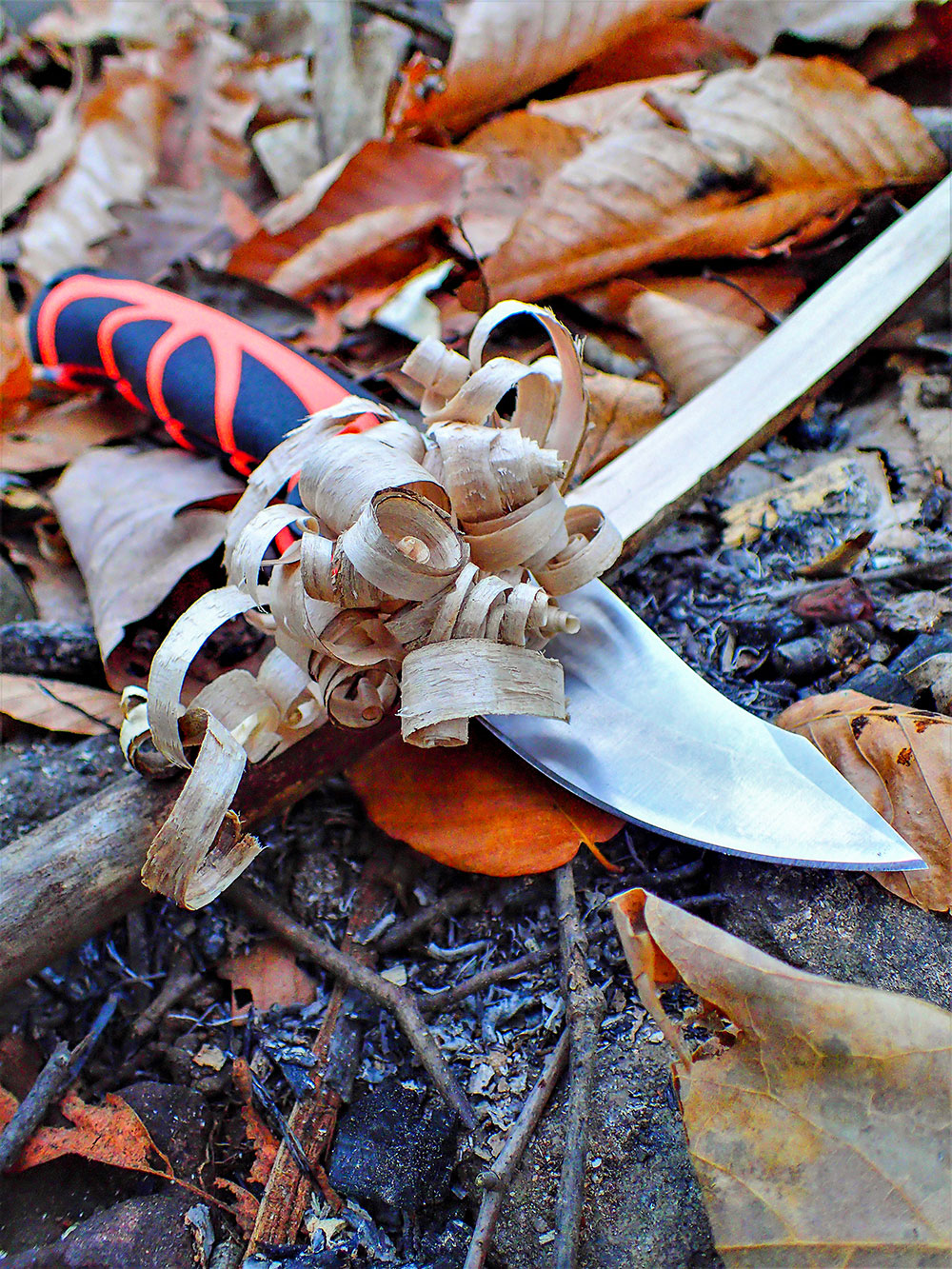
The author tested all the blades of the SOL Stoke lineup to ensure they can thinly shave wood for use as tinder in wet weather.
Unlike the Pivot Knife, the jimping on the spine did not give my palm any sore spots when gripping in a fist grip as they were situated higher. The fixed blade gave a solid performance on camp food slicing and woodworking. The question is, do you favor a combo blade for woods use or a plain edge? Is a hollow ground blade your preference, or is it good enough? I require a blade grind to be two things—sharp and easy to resharpen.
UNIVERSAL UTILITY
To me, a folding knife is the go-to utility knife that must be ready to be called upon for a plethora of tasks. The universal 3.25-inch blade (partially serrated) of the Stoke Folding Knife is about the right size for a pocket/utility folder. It comes in a riveted nylon sheath with a loop for the ferro rod and fold-over snap closure. The sheath is meant to be worn conventionally or scout style on the belt, which refers to a 90-degree (horizontal) angle.
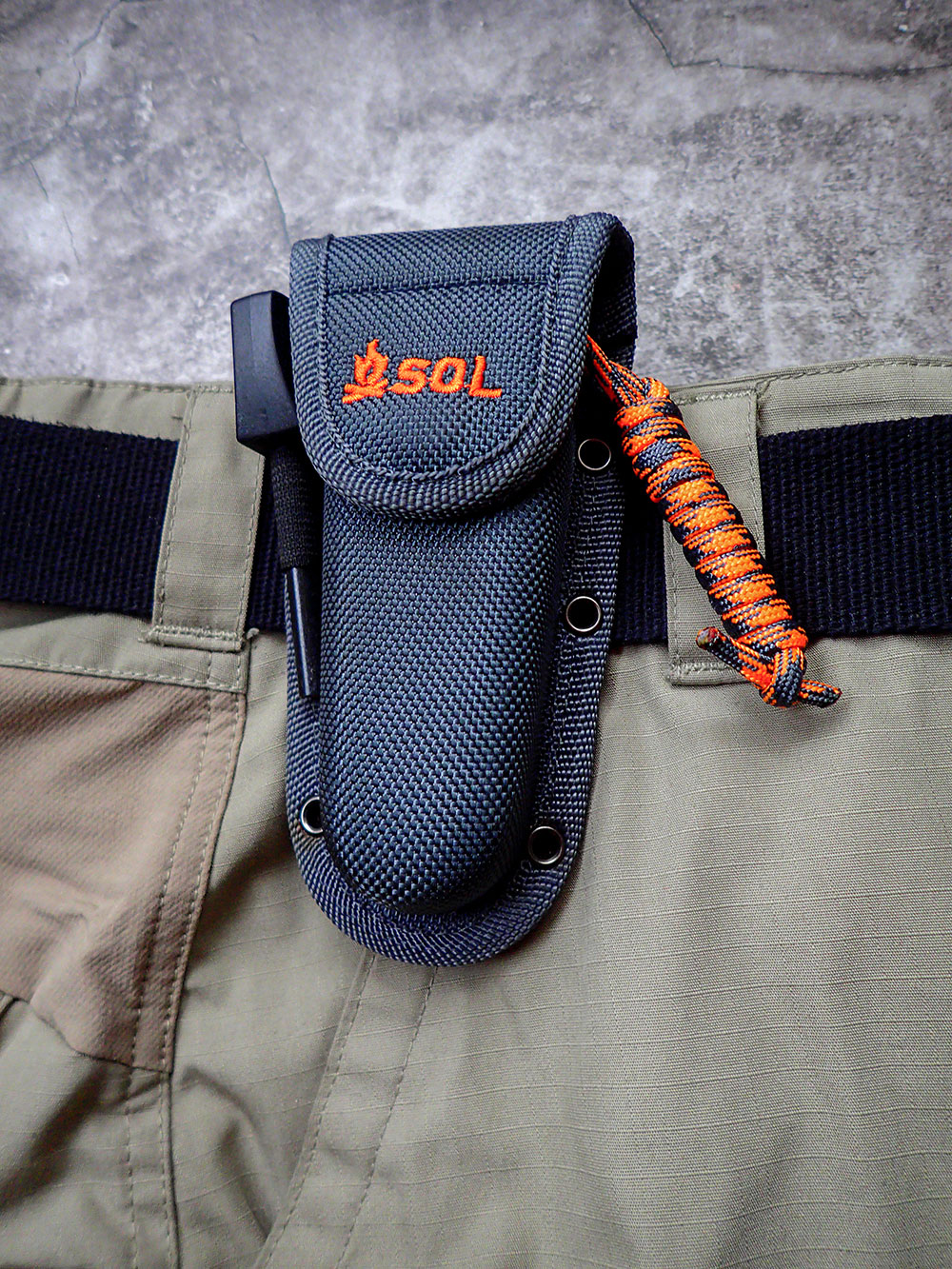
The Stoke Folding Knife and ferro rod come in a sturdy riveted holster for your belt. This makes the knife appear as more of a tool than a weapon to sheepish onlookers.
This gives the knife a more utility tool appearance, however the knife can be carried in a pocket; there is no pocket clip. The liner lock was smooth and locked securely. It seemed to be made of aluminum, but I couldn’t find any available info on it specifically. The simple folder has Teflon washers, stainless steel screws, spacers, and ambidextrous thumb studs.
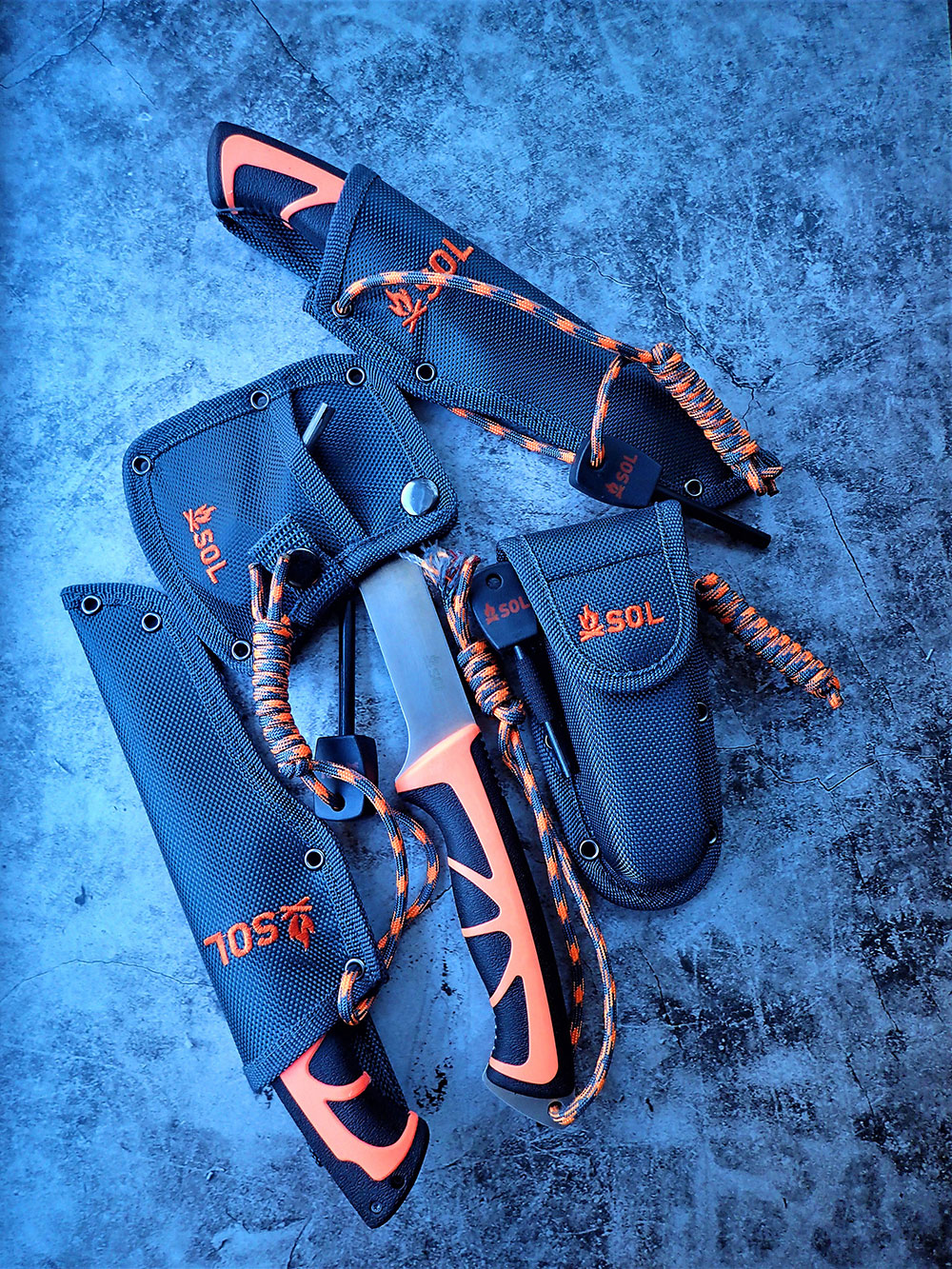
Only heavy-duty nylon sheaths for the SOL Stoke cutting tools. Each sheath is meant to keep the cutting edge away from your gear and out of the elements. The hatchet and folding knife have a place to keep the SOL ferro rod secured, while the other tools have a lanyard attached to the rivets to hold the ferro rod.
I ran the Stoke Folding Knife through my personal gauntlet of materials. I cut several scrap cords from electronic cables and phone cords that were no longer functional. Zipties and 550 paracord were next, switching between the serrated portion and plain edge. Package duty involved slicing open paper, plastic and breaking down cardboard boxes to fit in the recycling bin.
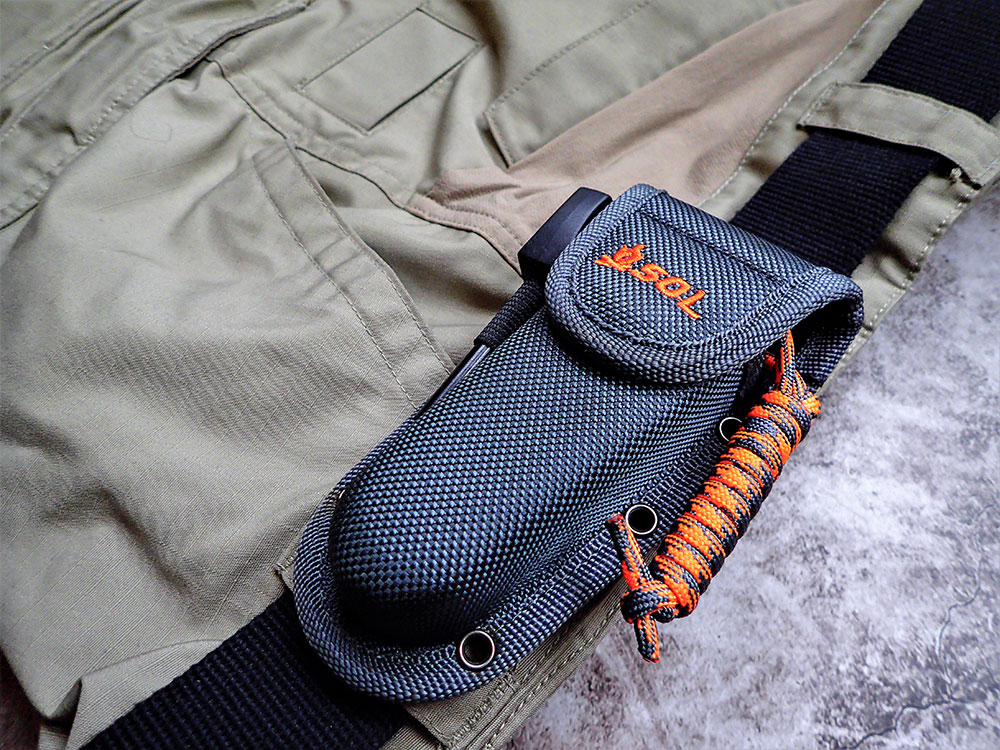
Horizontal/scout carry is an option due to the belt loops built into the robust, riveted sheath.
Cardboard is harsh on any cutting instrument, and knives are no exception. The plain edge sliced with authority, but the serrations dragged a little and made a shredded cardboard mess. An old leather work glove was slashed with the straight and serrated portion of the blade as well as stabbed, then sliced in a slashing motion, which was fun. The edge did well on leather.
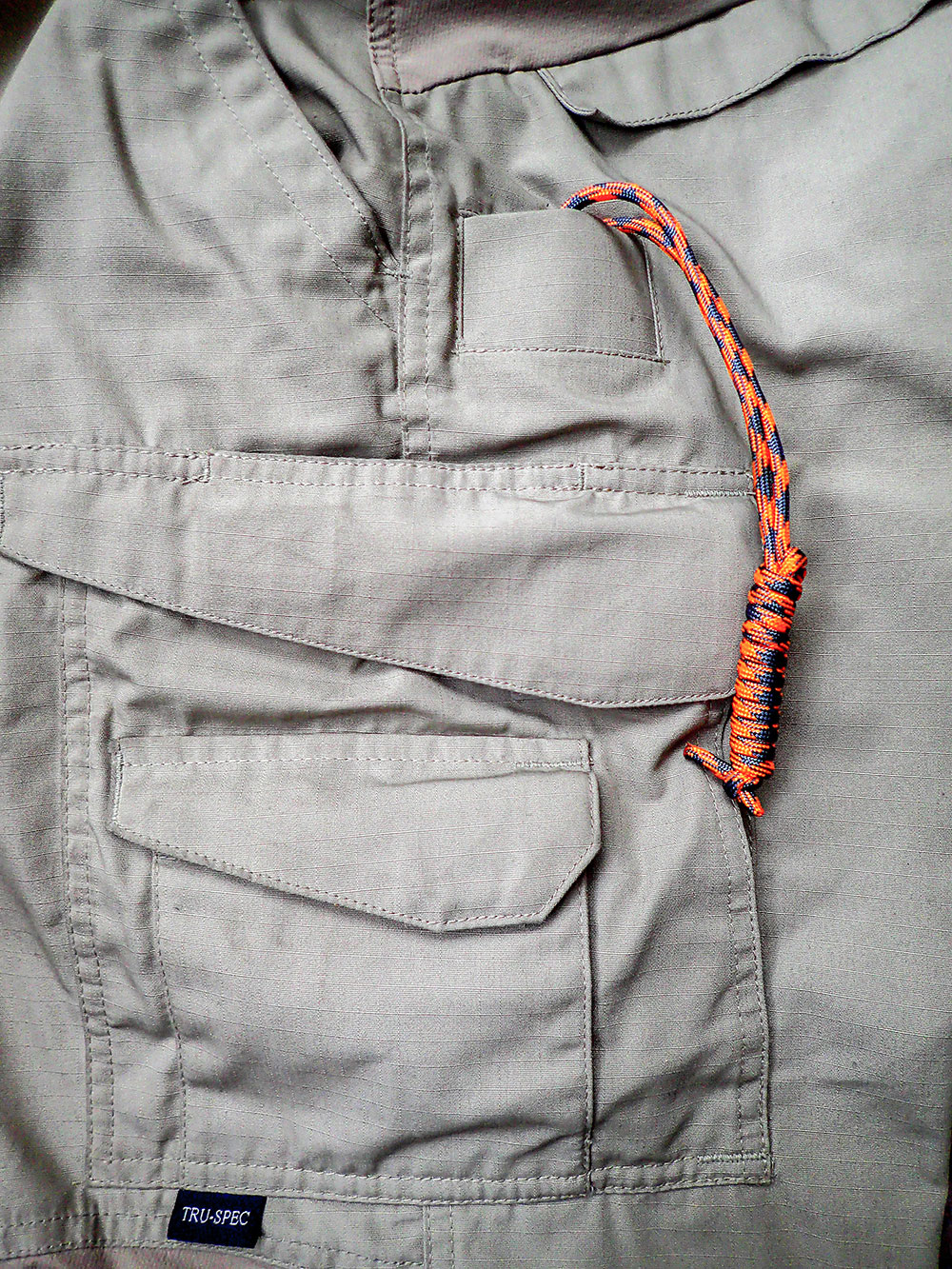
In a pocket made for folding knives or flashlights, the Stoke Folder disappears yet remains readily available.
Then the Altoids tin and medium-weight food can were next. Each got two ice-pick grip stabs while wearing a heavy leather glove, mainly to look like a pro. The edge showed a little bit of degradation, as expected. Without sharpening it, I tackled the heavy-duty tow strap. After the other tests, the blade struggled to cut through; the serrations kicked in where the plain edge would only slide on the fibrous material. I feel this would have resulted more favorably if I started the cutting tests with the tow strap. All in all, it still accomplished 95-percent of the cutting tasks I threw at it as they cover most realistic utility knife chores.
JOB ACCOMPLISHED
With these SOL products, you can light a fire with the tinder cord lanyard and ferro rod, and feel confident when making cuts using tools with textured, PP/TPR handles for a secure grip. Don’t worry about corrosion with these tools. Whether you need a combo knife/saw, a small hatchet to keep your wood stove burning bright, a sturdy field knife, or combo edged utility folder, SOL has you covered.
SPECS
Stoke Camp Hatchet
Overall Length: 10 7/8 inches
Blade: 3 inches
Width: 3 ¾ inches
Steel: 420 stainless steel
Handle Material: Polypropylene/TPR
Weight: 10 ounces (12 ounces w/sheath)
Sheath: Nylon
Multitool Function: Three sizes of hex wrenches, integrated rope cutter
- Ferrocerium rod included
MSRP: $34.99
Stoke Pivot Knife & Saw
Overall Length: 10 inches
Blade: Knife 3.9 inches, saw 4.24 inches
Steel: 420 stainless steel
Handle Material: Polypropylene/TPR
Weight: 10.6 ounces (12 ounces w/sheath)
Sheath: Nylon
- Ferrocerium rod included
- Made in China
MSRP: $29.99
Stoke Field Knife
Overall Length: 9 inches
Blade: Knife 3.9 inches
Steel: 420 stainless steel
Handle Material: Polypropylene/TPR
Weight: 8 ounces (11 ounces w/sheath)
Sheath: Nylon
- Ferrocerium rod included
- Made in China
MSRP: $27.99
Stoke Folding Knife
Overall Length: 8 inches
Blade: Knife 3.25 inches
Closed Length: 4.6 inches
Steel: 420 stainless steel
Handle Material: Polypropylene/TPR
Weight: 4 ounces (6 ounces w/sheath)
Sheath: Nylon
- Ferrocerium rod included
- Made in China
MSRP: $27.99
SOURCE
Adventure Ready Brands
944 Industrial Park Road
Littleton, NH 03561
800-324-3517
cs@adventurereadybrands.com
SurviveOutdoorsLonger.com
ABOUT ADVENTURE READY BRANDS
The headquarters of Adventure Ready Brands is located in the heart of the White Mountains in Littleton, New Hampshire. The company was founded in 1973, incorporated in 1977, and manufactures a full line of well-known insect repellents such as Ben’s and Natrapel, and the world-famous insect bite treatment, After Bite. In addition, the company offers first-aid items such as Adventure Medical Kits and Easy Care First Aid kits along with survival products from Survive Outdoors Longer (SOL) and burn remedy products such as AfterBurn. Many products are packaged in innovative ways that allow them to be convenient to use and environmentally friendly.
A version of this article first appeared in the May/June 2022 print issue of Knives Illustrated.

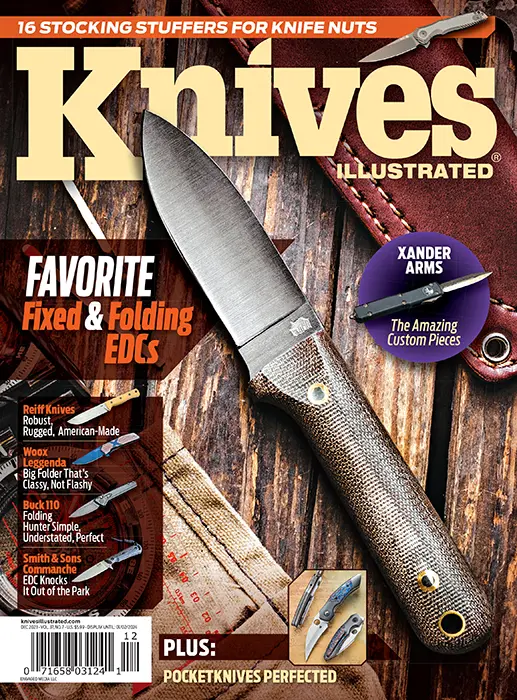 Subscribe / Back Issues
Subscribe / Back Issues